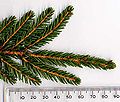|
Picea orientalis
Picea orientalis, commonly known as the Oriental spruce[2] or Caucasian spruce, is a species of spruce native to the Caucasus and adjacent northeast Turkey. DescriptionIt is a large coniferous evergreen tree growing to 30–45 m tall or 98–145 feet (exceptionally to 57 m), and with a trunk diameter of up to 1.5 m (exceptionally up to 4 m). The Caucasian Spruce can also be found in Northern Iran, though its numbers have decreased due to deforestation.[citation needed] The shoots are buff-brown and moderately pubescent (hairy). The leaves are needle-like, the shortest of any spruce, 6–8 mm long, rhombic in cross-section, dark green with inconspicuous stomatal lines. The cones are slender cylindric-conic, 5–9 cm long and 1.5 cm broad, red to purple when young, maturing dark brown 5–7 months after pollination, and have stiff, smoothly rounded scales. CultivationIt is a popular ornamental tree in large gardens, valued in northern Europe and the USA for its attractive foliage and ability to grow on a wide range of soils. It is also grown to a small extent in forestry for Christmas trees, timber and paper production, though its slower growth compared to Norway spruce reduces its importance outside of its native range. P. orientalis[3] and the cultivars 'Aurea' [4] and ‘Skylands’[5] have gained the Royal Horticultural Society's Award of Garden Merit.[6] A frequently seen ornamental cultivar is Picea orientalis 'Aureospicata', which has gold-coloured young foliage in the spring.
References
External linksWikimedia Commons has media related to Picea orientalis.
|
||||||||||||||||||||||||||||||||||






